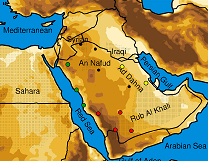Dust and soiling analysis
Dust and soiling analysis service |
|
|
SoDa can offer a study of dust event frequency and intensity for a given location, based on the analysis of the meteorological METAR codes at the nearest airport. Please find here a typical report which can be produced. The report contains the following sections:
|
|---|
"Does HC3v5 take into account the evolution of the atmospheric dust content?"
HelioClim-3v5 is using the CAMS McClear clear-sky model which takes into account the atmospheric dust.
The McClear model uses the atmospheric amounts of aerosols (dust, carbon, salt, etc ), water vapor and ozone to compute the sunlight scattering and diffusion in its down path through the atmosphere. The amounts of aerosols, water vapor and ozone are computed by ECMWF in the C-IFS numerical weather model.
A recent report from 2017 on the C-IFS model comparison to observations for year 2003 can be found here : http://atmosphere.copernicus.eu/sites/default/files/repository/CAMS84_2015SC2_D84.7.1.2_Y1_v1_0.pdf
The main finding of this report is certainly that CAMS C-IFS underestimates the amount of dust in North Africa and Middle East (chapter 3.1.2, page 27) but is in good qualitative agreement in terms of seasonal variations. For intance, if a big dust event happens, it is likely that the CAMS dust values will be impacted, but they will certainly not show the near extinction of the solar radiation.
Bibliography Dust
(In alphabetic order and and reverse chronological order)
| Ammar et al. 2014 |
K. Ammar • Mossad El-Metwally • Mansour Almazroui • M. M. Abdel Wahab, 2014. "A climatological analysis of Saharan cyclones", Clim. Dyn. (2014) 43:483–501. DOI 10.1007/s00382-013-2025-0 |
Dust, Sahara |
| Notaro et al. 2013 | Michael Notaro, Fahad Alkolibi, Eyad Fadda, and Fawzieh Bakhrjy, 2013. "Trajectory analysis of Saudi Arabian dust storms", Journal of Geographysical Research: Atmospheres, Vol. 118, 6028–6043, doi:10.1002/jgrd.50346, 2013 | Dust storms, air parcel trajectories |
Content: Temporal and spatial characteristics of Saudi Arabian dust storms, with focus on
associated air parcel trajectories, are investigated using station and gridded weather
observations and remotely-sensed aerosol optical depth (AOD)
| Rezazadeh et al. 2013 | M. Rezazadeh, P. Irannejad, Y. Shao, 2013. "Climatology of the Middle East dust events", Aeolian Research 10 (2013) 103–109. http://dx.doi.org/10.1016/j.aeolia.2013.04.001 | Dust sources, dust in suspension, blowing dust, dust storm |
| Sayyah et al. 2014 | Arash Sayyah, Mark N. Horenstein, Malay K. Mazumder, 2014. "Energy yield loss caused by dust deposition on photovoltaic panels", Solar Energy 107 (2014) 576–604. http://dx.doi.org/10.1016/j.solener.2014.05.030 | Dust accumulation, Loss of transmission, reflectivity, cleaning methods |
| Song et al. 2007 | Zhenxin Song, Jinyan Wang, and Shigong Wang, 2007. "Quantitative classification of northeast Asian dust events", JOURNAL OF GEOPHYSICAL RESEARCH, VOL. 112, D04211, doi:10.1029/2006JD007048, 2007 | Dust accumulation, Loss of transmission, reflectivity, cleaning methods |
Content: quantitative classification of dust events on the basis of dust, PM10 (Particle Matter) concentration, and wind speed for northeast Asia


